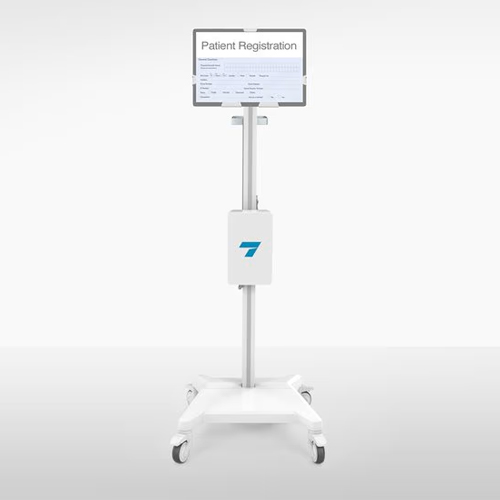- Total cart height of 72”
- 22” x 20” base, IEC 60601 tested for tip resistance
- Offset design for optimal balance and aesthetics
- Integrated handle for easy maneuvering
- Front- or rear-mounted utility box for safe power management
- Concealed cable management for safe and secure operation
- Modular design compatible with a range of Tryten accessories
- Whisper-quiet, non-marking, locking wheels
- Medical-grade, easy to clean components
Medical Mounts Carts and Stands
Hiliex offers high-quality medical mounts, carts, and stands for transporting medical-grade monitors. Contact us to purchase a high-quality medical display cart.
What is a Medical Display Cart?
A medical display cart is a mobile, ergonomic workstation designed to support and transport medical-grade monitors and related equipment within healthcare settings. These carts play a crucial role in enhancing the functionality and flexibility of medical imaging systems, providing a stable and convenient platform for medical professionals to view and interact with diagnostic images and surgical visuals.
-

-

- Patented height-adjustable articulating arm
- Lockable tablet holder fits tablets up to 12.95” and 3.5 lbs
- Available in a Vesa mount configuration
- Concealed cable management for safe and secure operation
- Modular design compatible with a range of Tryten accessories
- Whisper-quiet, non-marking, locking wheels
- Medical-grade, easy to clean components
- IEC 60601 tested for tip resistance
Key Features and Benefits
1. Mobility and Flexibility
- Easy Transport: Medical display carts are equipped with smooth-rolling casters, allowing easy movement across different areas within a healthcare facility, such as operating rooms, patient wards, and diagnostic centers.
- Adaptable Positioning: These carts often feature adjustable height and tilt mechanisms, enabling clinicians to position the display at the most comfortable and ergonomically appropriate angle for viewing.
2. Ergonomic Design
- User Comfort: Designed with user comfort in mind, medical display carts help reduce physical strain on healthcare professionals by allowing them to adjust the cart's height and monitor angle to suit their preferences.
- Optimized Workflow: By providing a mobile and adjustable platform for displays and other equipment, these carts help streamline workflows,making it easier for clinicians to access and interpret medical images without unnecessary interruptions.
3. Integrated Equipment Management
- Accessory Mounts: Many medical display carts come with mounts and brackets for additional equipment such as keyboards, mice, barcode scanners, and other peripherals, ensuring all necessary tools are within easy reach.
- Cable Management: Effective cable management systems keep wires organized and out of the way, reducing clutter and minimizing the risk of tripping hazards in busy medical environments.
4. Sturdy and Reliable Construction
- Durability: Built to withstand the rigors of a medical setting, these carts are constructed from high-quality materials that ensure long-lasting durability and stability.
- Load Capacity: Designed to support heavy medical-grade monitors and other equipment, medical display carts offer robust load capacities, ensuring the equipment remains secure and stable during use and transport.
5. Enhanced Clinical Efficiency
- Point-of-Care Access: Medical display carts enable clinicians to bring high-resolution diagnostic displays directly to the point of care, facilitating on-the-spot consultations and decision-making.
- Multi-Disciplinary Use: These carts are versatile and can be used across various departments, including radiology, surgery, emergency care, and patient monitoring, making them an essential asset in any healthcare facility.
Applications of Medical Display Carts
-
- Surgery
- Real-Time Imaging: In the operating room, medical display carts provide surgeons with real-time access to high-definition images and videos, enhancing precision during procedures.
- Endoscopic Procedures: These carts support endoscopic monitors for minimally invasive surgeries, allowing surgeons to view detailed internal images.
- Surgery
2. Radiology
- Diagnostic Imaging: Radiologists use medical display carts to review and interpret diagnostic images, such as X-rays, CT scans, and MRIs, with the flexibility to move the display to different workstations as needed.
3. Emergency and Critical Care
- Patient Monitoring: In emergency and critical care settings, medical display carts facilitate continuous monitoring of patient's vital signs and imaging data, providing immediate access to critical information.
4. Telemedicine
- Remote Consultations: Medical display carts can be equipped with cameras and communication tools to support telemedicine, enabling remote consultations and real-time collaboration with specialists.
Looking for the Best Medical Display Cart?
Get in touch with us to discuss your requirements for a medical display cart, and we will help you make a wise decision.
